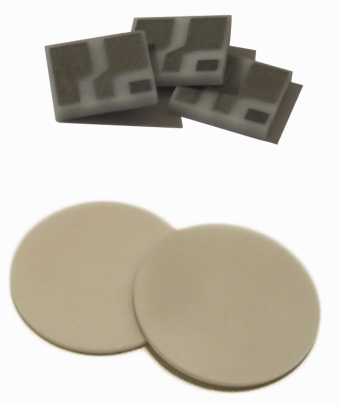Beryllium oxide ceramic substrates (BeO)

Beryllium oxide [BeO] has a unique combination of thermal, electrical, optical and mechanical properties that are used for a wide range of applications: from thermal control systems and integrated electronics to high-temperature refractory components and nuclear reactors. Beryllium oxide has no analogues among oxide-ceramic materials in terms of thermal conductivity.
BeO-based ceramics have a thermal conductivity exceeding that of many metals, second only to copper and silver. At the same time, the thermal conductivity of BeO is 10 times higher than that of Al2O3, and 1.5 times higher than that of AlN.
The dielectric constant is lower than that of aluminum oxide and nitride. In this connection, BeO is an excellent insulator with a volumetric resistance of the order of 1014 ... 1018 ohms * cm, which depends on the purity of the material.
In addition to high heat resistance, BeO has excellent strength with high values of specific stiffness. Ceramics based on beryllium oxide BeO are produced according to ТУ23.43.10-008-34576770-2017 under the trademarks OБK-97 and OБK-100.
Specifications

|
Properties |
Material |
|
|
BeO |
||
|
Colour |
White |
|
|
Bulk density |
г/см3 |
≥ 2,85 |
|
Surface roughness Ra (grinding) |
мкм |
— |
|
Surface roughness Ra (polished) |
мкм |
- |
|
Mechanical properties |
||
|
Flexural strength |
МПа |
≥ 180 |
|
Physical properties |
||
|
Coefficient of thermal expansion (25-1000°C) |
10 -6 /°C |
7,0 ~ 8,5 |
|
Thermal conductivity (25°C) |
Вт/м∙°K |
≥ 230 |
|
Specific heat capacity |
Дж/кг*К |
- |
|
Heat shock resistance |
С |
800 |
|
Dielectric strength |
кВ/мм |
≥ 18 |
|
Volumetric resistance (25 С) |
Ом∙см |
≥ 1014 |
|
Dielectric constant(1 МГц) |
- |
6,5 ~ 7,3 |
|
Dielectric losses (1МГц, 25°C) |
∙10 -4 |
≤ 4 |
|
Metallisation |
||
|
DBC technology |
- |
|
|
Thick-film technology |
- |
|
|
Thin-film technology |
|
|
Application area
Substrates based on beryllium oxide can be used for:
- as boards for radio engineering devices operating with microwave radiation. The basis for the manufacture of "traveling wave lamps";
- substrates for solid-state emitters;
- creation of integrated circuits for X-ray devices;
- as a housing for heating elements;
- substrate for ionizing radiation sensors.